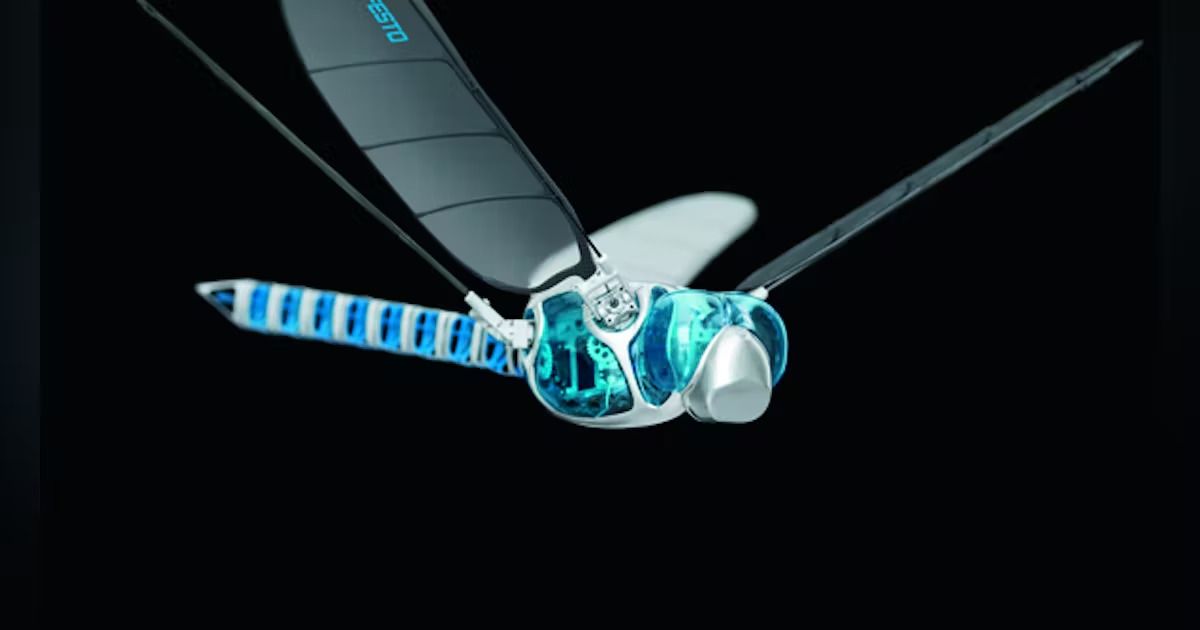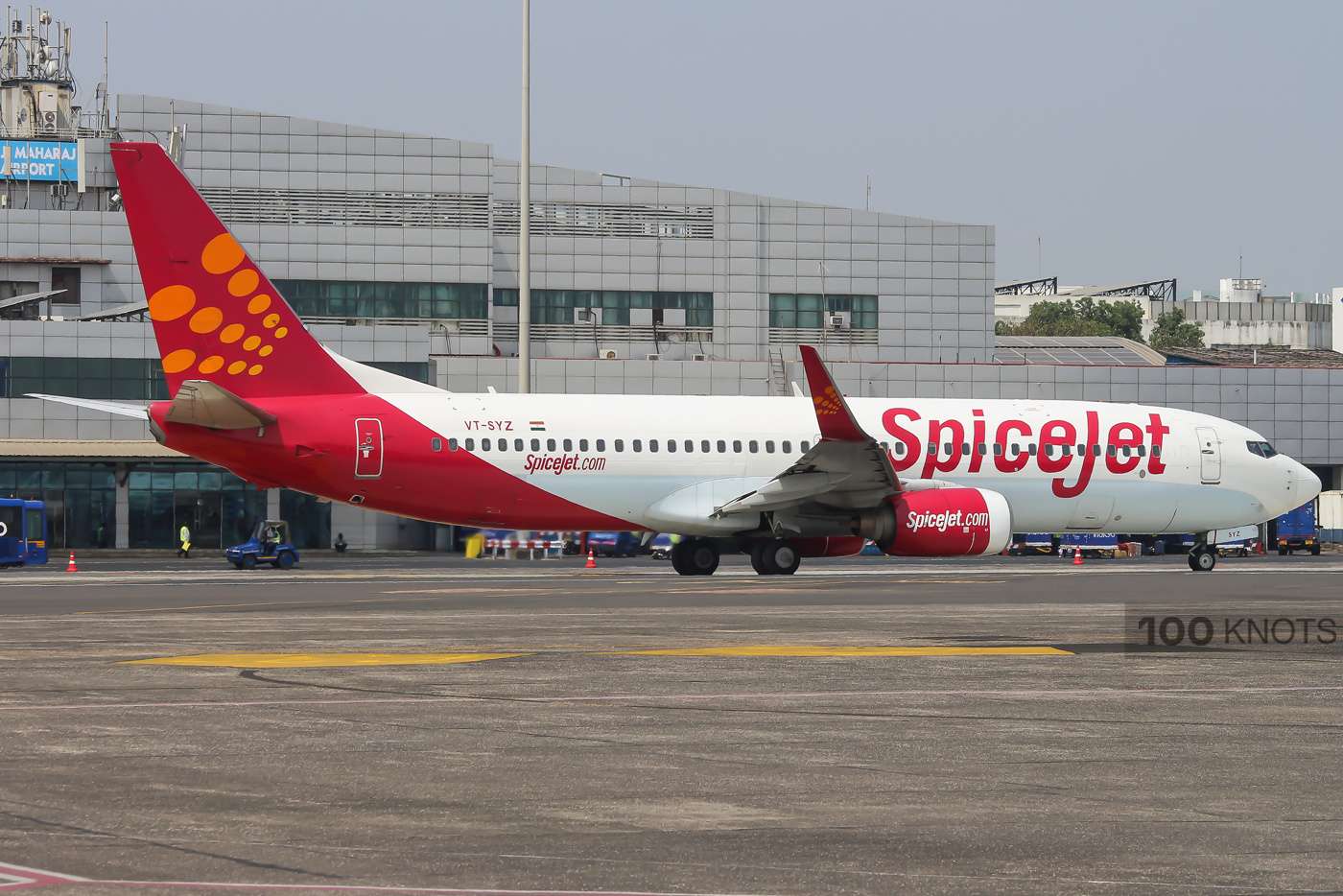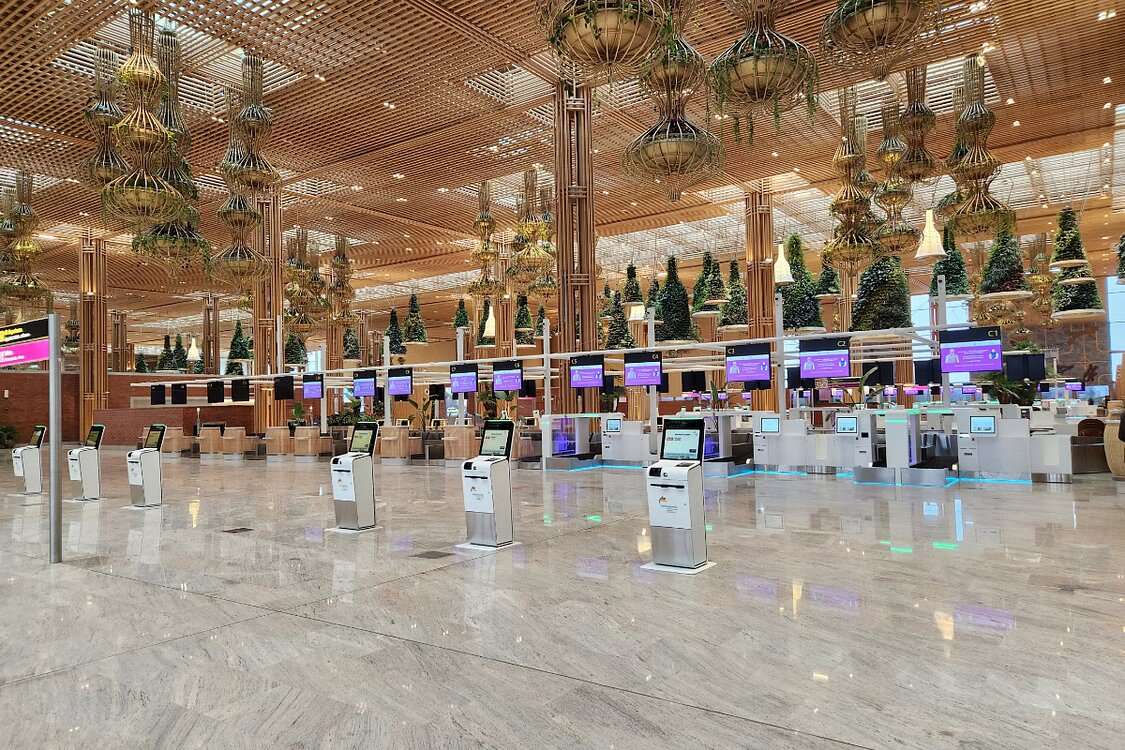Could a humble dragonfly pave the way for a safe and autonomous flight?
Prashant-prabhakar
14 Jan 2023

Continuous progress is the goal when it comes to safety. Airbus is always looking for new inspiration to develop proactive solutions that can raise performance and safety.
Representative | Airbus
And what better place to get inspiration from than the magnificent natural world? Airbus's "sharklet" wing-tip design, which decreases drag, and the fello'fly demonstrator, which imitates the formation flying of snow geese for better performance, are just a few of the innovative solutions it has developed as a result of biologically inspired engineering, also known as "biomimicry".
Airbus
The recent biomimicry demonstration from Airbus, called DragonFly, was motivated by the common, humble "dragonfly."
A dragonfly's exceptional vision, 360-degree vision, and ability to recognize landmarks enable it to clearly determine the limits of its territory. Similar to how the systems the company is researching and developing review and recognize landscape elements to help the aircraft "see" and safely maneuver in its surroundings.
Especially in the context of emergency operations, these advances may add another level of safety to aircraft. In the odd event that a crew loses control of the plane, DragonFly can reroute the flight to the closest suitable airfield and help with a secure landing.
Decoding "DragonFly"
When it comes to derisking emergency operations, DragonFly could be a game-changer. Its three main areas of focus each support automated yet thoughtful decision-making by combining data collected during flight with a massive corpus of flight information.
Representative | Royal Aeronautical Society
In order to help assure safe flight and landing, DragonFly provides a solution. The onboard system recognizes a problem and automatically chooses the best airport to guide the aircraft toward if the crew is unable to manage it.
Of course, flight routes and outside variables are complicated and dynamic. A dragonfly explores its surroundings before adjusting its course. Similar to this, the DragonFly prototype makes its landing decisions by taking into account the environment, including flight lanes, topography, and weather. However, in contrast to a typical dragonfly, the DragonFly additionally gains from a continuous line of communication between the aircraft and both Air Traffic Control and the airline's Operations Control Center to guarantee a secure and well-coordinated approach.
L'Usine Nouvelle | Representative
In the same way that dragonflies can recognise landmarks that help them to define boundaries, our demonstrator is equipped with cutting-edge sensing technology and software, capable of managing in-flight and landing operations. The DragonFly demonstrator has been made possible through cooperation within the Airbus engineering community and with our trusted external partners, and we look forward to the insights that this final stage of testing will deliver- Isabelle Lacaze, Head of DragonFly demonstrator, Airbus UpNext
Possible safe and automated landing at any airport in the world
Airbus has developed a system that combines sensors, computer vision algorithms, and reliable navigation calculations to greatly simplify landing in poor visibility or challenging weather circumstances because a dragonfly's eyesight functions much more swiftly than a human's.
The technologies were able to help pilots throughout the flight test campaign when handling a simulated disabled crew member event, as well as during landing and taxiing operations. The aircraft was able to construct a new flight trajectory plan and interact with both Air Traffic Control (ATC) and the airline operations control center while taking into account external factors like flight zones, topography, and weather conditions.
These advancements open the door for an automatic landing (if required) or can be tailored to the pilot's flying abilities to relieve them of extra steps in an emergency or critical circumstance.
In the future, DragonFly's advancements may make it possible for the plane to land at any airport in the world, regardless of whether the airport has the ground equipment necessary for automatic landing.
The crew of the DragonFly demonstration can manage taxi guidance and instructions, including navigation and surveillance, with the use of pilot assistance technology, giving them up to concentrate on other crucial responsibilities.
Airbus
Airbus has started testing new, on-ground, and in-flight, pilot assistance technologies on an A350-1000 test aircraft.
Moving forward
The final three months of DragonFly's testing phase have already begun. Through these test flights, Airbus UpNext will be able to upgrade or validate the technology in order to incorporate advancements into the next programs.
Along with these features, Airbus UpNext is starting a project to develop the newest computer vision-based algorithms for improved landing and taxi assistance.
https://www.youtube.com/watch?v=nubL1I7sxEE
Cooperation between Airbus divisions and outside partners, such as Cobham, Collins Aerospace, Honeywell, Onera, and Thales, allowed for the execution of these tests. The French Civil Aviation Authority (DGAC) provided some funding for DragonFly as a part of the French Stimulus plan, which is a component of the European Plan, Next Generation EU, and the France 2030 plan.
SOURCE: Airbus
COVER: Machine Design
Read next
NCLT allows Jet Airways ownership transfer to Jalan-Kalrock consortium; gives 6 months to complete the process
Radhika Bansal
14 Jan 2023
The National Company Law Tribunal (NCLT) on Friday, January 13 allowed the ownership of Jet Airways to be transferred to the Jalan Kalrock Consortium (JKC), which had won the bid to resurrect the grounded carrier in 2021.
This comes as the consortium has appealed to the Supreme Court against a separate ruling by the National Company Law Appellate Tribunal (NCLAT) directing it to clear unpaid provident fund dues of INR 250 crore to employees, said multiple people aware of the development, highlighting the legal hurdles that remain for the new owners.
An NCLT division bench of justice PN Deshmukh and technical member Shyam Babu Gautam allowed JKC’s seek the transfer of Jet's ownership in an oral order. The ownership currently vests with the monitoring committee comprising Jet's lenders, JKC executives and the court-appointed resolution professional.
The court gave its approval despite lenders' contention that JKC had not fulfilled all conditions--including securing Jet's domestic flight slots and international traffic rights—as per the resolution plan, which is effective November 18.
The resolution applicant usually has 180 days to clear all dues to creditors but the NCLT has acceded to JKC’s demand that this is extended. It has until May 2023 to clear all dues to lenders, other creditors and workers.
The NCLT rejected an oral demand by the lenders to stay in the operation of the Friday order for two weeks so that they can challenge the ruling in the NCLAT. JKC has said it will spend INR 1,375 crore - INR 900 crore as capital infusion and INR 475 crore paid to creditors. Of that, INR 380 crore will go to financial creditors. JKC is to have an 89.79% stake while 9.5% will go to lenders.
“The NCLT order implies that the airline’s handover and distribution are segregated,” the person said. “The standoff between lenders and the resolution applicant on payment of uncleared dues to employees delayed the handover of the airline.”
Naresh Goyal founded Jet Airways, once India's biggest private carrier, stopped operations on April 17, 2019, unable to cope with its financial liabilities. It was taken to bankruptcy court by the airline's lenders. JKC's plan was approved by the NCLT in June 2021. Since November 2022, there has been a tussle between lenders and JKC over unpaid dues.
Read next
The cargo service at Pune airport resumed partially after SpiceJet and IndiGo took approval from the Bureau of Civil Aviation Security Instructions (BACS).
The Airports Authority of India abruptly suspended cargo service at the Pune airport by the Bureau of Civil Aviation Security Instructions (BACS) on January 1.
“The cargo service was suspended at the Pune international airport as many airlines had not taken approval of running cargo service from BACS. Many airlines are in the process of taking approval. Currently, two airlines have received approval – SpiceJet and IndiGo. Their cargo services resumed from January 3. Air India, GoFirst, Vistara and AirAsia are waiting for approval. Once these airlines receive the approval their cargo services will also resume."
Santosh Dhoke, Airport Director, Pune
As per officials, goods of at least 100-120 tonnes are transported from Pune airport daily.
Once the new terminal building is ready at the Pune International Airport – the cargo service will be shifted to the new building. The new cargo terminal will have a capacity of 36,000 tonnes. It will be called an ‘interim integrated air cargo terminal, ' and will be ready by March 2023. AAI Cargo Logistics and allied services company will oversee the operations of this cargo facility at its new location.
Pune Airport resumes partial cargo operations
The current capacity of cargo transportation in Pune is 25,000 metric tonnes, of which 17,000 is domestic and 7,500 is international.
Airport authorities plan to construct an international air cargo terminal in Pune which is expected to be ready by December 2024. The current cargo hold area will shift to make way for the terminal building. An integrated cargo terminal is under construction on land provided by the Indian Air Force and operations will begin here by March this year.
ALSO READ - Pune Airport to get a new terminal building by May 2023: Scindia
Read next
One ex-pat pilot flying for Alliance Air was detained by Indian Air Force security on Monday for allegedly taking pictures and videos of a restricted aerodrome at the Uttarlai Air Force Station, Rajasthan on his mobile phone. Hired to operate a charter flight to Delhi, the pilot has had a formal complaint lodged against him, by the IAF, with the Directorate General of Civil Aviation (DGCA). He was hired to operate Alliance Air charter flight 9I962, with 23 passengers on board a ATR 72-600(VT-AIZ) aircraft. The incident occurred while the flight was readying for departure from Uttarlai to Delhi “Boarding was on when the pilot, a Brazilian national, started taking videos of the air force station. It’s not known if he was shooting out of curiosity, as an aviation enthusiast or if there were other reasons. He was caught by the IAF security personnel and detained for questioning,” said a TOI source. The charter flight was to depart around noon, but with the pilot not available, the aircraft stayed on ground for close to five hours, the source said, adding that the flight finally departed for Delhi late evening. "The incident has caused much consternation among the airline officials, especially with Republic Day a few weeks away," they added. Under the IAF norms laid down for operation of civil flight from its aerodromes, “no aerial/ ground photography from the aircraft is permitted and no sensory equipment is to be carried by passengers in hand bags." Civil non-schedule flights (charter flights) with foreign crew members can operate to these IAF air stations only after obtaining clearance from the Defence Ministry. For foreign crew members, airlines operating scheduled flights are required to obtain clearance from ministry of home affairs (IB) and ministry of external affairs. Uttarlai Air Force Station in Barmer, Rajasthan lies close to the country’s border with Pakistan. Given its geographical proximity, the station played a critical role in the Indo-Pakistan war. An Alliance Air spokesperson said that the pilot concerned has been 'de-rostered pending investigation'.
Read next
A call was received regarding the presence of a bomb in a Delhi-Pune SpiceJet plane before its take off on Thursday, January 12, police said. All the passengers and crew members are safe, they said, adding that the aircraft is being checked.
Sources said the estimated departure time of the plane -- SG 8938 -- was 5:35 PM. The passengers were at the boarding gate and not inside the aircraft when the call was received, they added.
"Officials of the CISF and the Delhi Police are on alert. We were informed by authorities regarding a call they received where the caller said there was a bomb in the Pune-bound SpiceJet plane. The plane is being checked but nothing suspicious has so far been found. However, we are following the security drill by our standard operating procedure," a senior police officer said.
Hoax bomb call received in a Delhi - Pune SpiceJet flight
At that time, boarding of passengers for the flight had not started, an airline spokesperson said in a statement on Friday, January 13.
Following the call, the aircraft was moved to an isolation bay and was thoroughly inspected by security officials."Nothing suspicious was found. The call was later declared a hoax," the spokesperson said.
The officer said efforts are also to trace the caller and ascertain if it was a hoax call.
ALSO READ - Hoax bomb threat on IndiGo flight
Read next
Airline operations at the much-awaited Terminal 2 (T2) of Bengaluru’s Kempegowda International Airport (KIA) will begin on January 15. While the only airline that will run on the day is Star Air, other domestic airlines will begin operations in a few days.
https://twitter.com/OfficialStarAir/status/1613932285656723456
Prime Minister Narendra Modi inaugurated Terminal 2 of the airport on November 11 last year. The first Star Air flight from Bengaluru to Kalaburagi is scheduled to take off at 8:40 am on January 15.
“We are delighted to announce the commencement of operations from the all-new T2 at Kempegowda International Airport, Bengaluru. Our passengers have been using Terminal 1 since the start of our operations in January 2019. We are excited to be the first airline to make a transition to this new and state-of-the-art terminal on the cusp of our 4th anniversary.”
Simran Singh Tiwana, CEO, Star Air
The terminal, for which planning began in 2018, is equipped to handle at least 25 million flyers annually. The phase 1 of Terminal 2 was built at a cost of INR 5,000 crore. It is spread across 2,55,000 sq m. Once phase 2 is ready, airport officials said, the terminal can handle 20 million more flyers. Combining Terminal 1 and Terminal 2, the airport will be able to handle at least 65 million flyers annually, according to the officials.
“We are ready to welcome customers of Star Air at our newly inaugurated Terminal 2, offering a distinctive and enhanced travel experience for the passengers. The new terminal will soon be opening doors to passengers of other airlines as well. This will be done in a phased manner as and when the facilities and processes for a smooth transition of airlines from T1 to T2 are completed.”
Hari Marar, MD & CEO of Bangalore International Airport Ltd (BIAL)
The terminal is also technically equipped right from the entry point to the point where flyers board aircraft, with automated biometric gates, self-baggage-drop counters, full body scanners and an automatic tray retrieval system adding to users’ convenience and efficiency.
Dedicated to the Garden City of Bengaluru, the airport resembles the environment of a garden, as it has sourced six lakh plants from ten ecological habitats around the country.
ALSO READ - BLR Metaport – First phase of the metaverse experience at Bengaluru airport launched




Comment